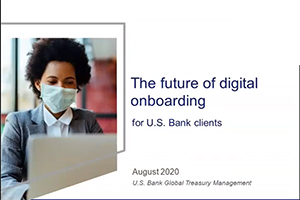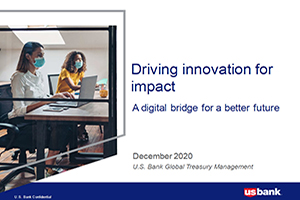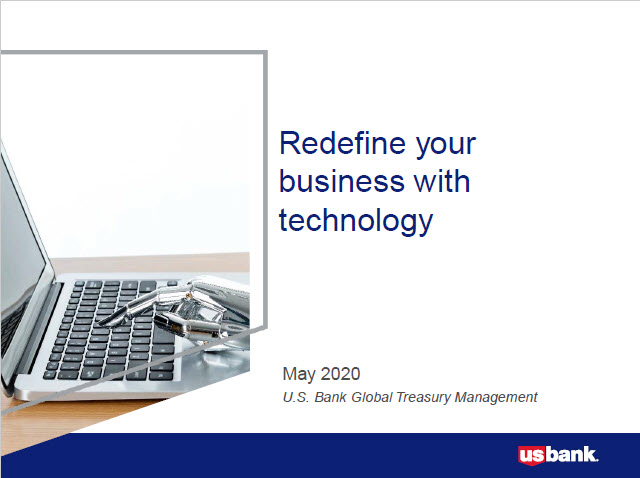
Putting home ownership within reach for a diverse workforce

Administrator accountability: 5 questions to evaluate outsourcing risks

Commercial real estate in 2020: Keeping up with the pace of change

Hybridization driving demand

Supply chain analysis: Merging technology and commerce

The ongoing evolution of custody

3 emerging technology trends for bankers

Cryptocurrency custody 6 frequently asked questions

High-yield bond issuance: 5 traits lawyers should look for in a service provider

Easier onboarding: What to look for in an administrator

Luxembourg's thriving private debt market

3 questions to ask your equity, quant and CTA fund administrator

3 tips to maintain flexibility in supply chain management

Private equity and the full-service administrator

The secret to successful service provider integration

Insource or outsource? 10 considerations

10 ways a global custodian can support your growth

Refining your search for an insurance custodian

The benefits of a full-service warehouse custodian

4 questions you should ask about your custodian

Preparing for your custodian conversion

Service provider due diligence and selection best practices

Integrated receivables management solution supports customer focus at MSC Industrial Supply

Hospitals face cybersecurity risks in surprising new ways

Webinar: Robotic process automation

Tactical Treasury: Fraud prevention is a never-ending task

Post-pandemic fraud prevention lessons for local governments

Webinar: Empower your AP automation with strategic intelligence

Webinar: Building digital bridges for treasury optimization

Evaluating interest rate risk creating risk management strategy

Authenticating cardholder data reduce e-commerce fraud

Webinar: AP automation—solve payment challenges with an invoice-to-pay solution

Webinar: CRE technology trends

Webinar: The future of digital onboarding for U.S. Bank clients

Webinar: Driving innovation to impact treasury management

Webinar: CRE treasury leader roundtable

Proactive ways to fight vendor fraud

Webinar: Redefine your business with technology

The latest on cybersecurity: Mobile fraud and privacy concerns

5 Ways to protect your government agency from payment fraud

The latest on cybersecurity: Vulnerability testing and third-party software

5 steps you should take after a major data breach

Fight the battle against payments fraud

Cybercrisis management: Are you ready to respond?

Complying with changes in fund regulations

The cyber insurance question: Additional protection beyond prevention

The password: Enhancing security and usability

Why KYC — for organizations

Cybersecurity – Protecting client data through industry best practices

Business risk management for owners of small companies

Webinar: CSM corporation re-thinks AP

Adjust collections to limit impact of USPS delivery changes

Tech tools to keep your restaurant operations running smoothly

Addressing financial uncertainty in international business

Webinar: AP automation for commercial real estate

The benefits of payment digitization: Pushing for simplicity

5 winning strategies for managing liquidity in volatile times

Artificial intelligence in finance: Defining the terms

The future of financial leadership: More strategy, fewer spreadsheets

3 timeless tips to reduce corporate payments fraud

Choosing your M&A escrow partner

Employee benefit plan management: trustee vs. custodian

Empowering managers with data automation and integration

Delivering powerful results with SWIFT messaging and services

New technology streamlines M&A transactions

Why retail merchandise returns will be a differentiator in 2022

High-cost housing and down payment options in relocation

How RIAs can embrace technology to enhance personal touch

The client-focused mindset: Adapting to differing personality types

The client-focused mindset: How to network effectively

The client-focused mindset: What do clients expect?

Flexibility remains essential for public sector workforces

Automated escheatment – learn how to prevent and resolve unclaimed property

Tailor Ridge eBill case study

What corporate treasurers need to know about Virtual Account Management

Webinar: CRE Digital Transformation – Balancing Digitization with cybersecurity risk

CFO survey: A shifting focus on ESG in business

Digital receivables to meet changing demand

Webinar: Reviving mobility, what to expect

CFO report: Driving growth via new business models and technology

CFO insights: Leading the recovery for sustainable growth

Webinar: DEI tips for transforming your mobility program

For today's relocating home buyers, time and money are everything

10 tips on how to run a successful family business

Crypto + Relo: Mobility industry impacts

Empowering team members

How entrepreneurs can plan for what matters most

Staying organized when taking payments

Tools that can streamline staffing and employee management

Key considerations for online ordering systems

Business tips and advice for Black entrepreneurs

How iPads can help increase efficiency in your salon

How does an electronic point of sale help your business keep track of every dime?

Planning for restaurant startup costs and when to expect them

Opening a business on a budget during COVID-19

How to identify what technology is needed for your small business

How to test new business ideas

How to get started creating your business plan

How to redefine challenges with business collaboration

8 ways to increase employee engagement

The role of ethics in the hiring process

How to hire employees: Employee referral vs. external hiring

Tips for building a successful customer loyalty program

Give a prepaid rewards card for employee recognition

Checklist: Increase lead generation with website optimization

How to reward employees and teams who perform well

5 steps for creating an employee recognition program

How small businesses are growing sales with online ordering

Gift cards can extend ROI into 2022

Omnichannel retail: 4 best practices for navigating the new normal

Is your restaurant Google-friendly?

3 simple brand awareness tips for your business

How a small business owner is making the workplace work for women

What you should know about licensing agreements

The growing importance of a strong corporate culture

Business credit card 101

How to apply for a business credit card

Meet your business credit card support team

Prioritizing payroll during the COVID-19 pandemic

How jumbo loans can help home buyers and your builder business

Break free from cash flow management constraints

5 tips for managing your business cash flow

Improve online presence your business

How Shampoo’ed is transforming hair and inspiring entrepreneurs

The San Francisco bridal shop that’s been making memories for 30 years

How Al’s Breakfast is bringing people together

Celebrity Cake Studio’s two decades of growth and success

In a digital world, Liberty Puzzles embraces true connection

How a bar trivia company went digital during COVID-19

How a travel clothing retailer is staying true to its brand values

How community gave life to lifestyle boutique Les Sol

How a group fitness studio made the most of online workouts

How to build a content team

How Wenonah Canoe is making a boom in business last

How (and why) to get your business supplier diversity certification

Use this one simple email marketing tip to increase your reach

Year-end financial checklist

4 ways to outsmart your smart device

How to spot an online scam

Learn how to spot scams related to COVID-19

Dear Money Mentor: What is cryptocurrency?

Webinar: Uncover the cost: International trip

How having savings gives you peace of mind

Allowance basics for parents and kids

Tips to overcome three common savings hurdles

Helpful tips for safe and smart charitable giving

5 tips to use your credit card wisely and steer clear of debt

30-day adulting challenge: Financial wellness tasks to complete in a month

Travel for less: Smart (not cheap) ways to spend less on your next trip

Real world advice: How parents are teaching their kids about money

How to stop living paycheck to paycheck post-pay increase

Practical money tips we've learned from our dads

How to cut mindless spending: real tips from real people

6 ways to spring clean your finances and save money year-round

How to increase your savings

5 tips to use your credit card wisely and steer clear of debt

How to spot a credit repair scam


